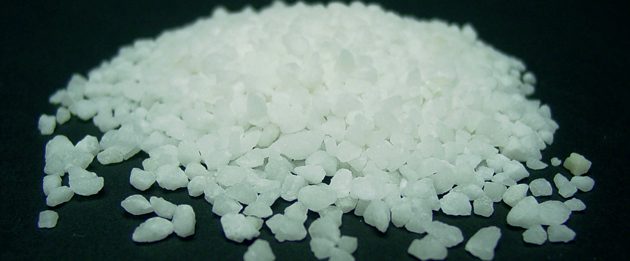
Urea, or carbamide, is an organic compound with the chemical formula (NH2)2CO that is synthesized from natural gas, not urine as frequently misstated. The molecule has two amine (-NH2) residues joined by a carbonyl (-CO-) functional group. Urea is the 14th highest volume chemical produced in the US. The primary use for urea is as a macronutrient ingredient in fertilizers where it provides a ready source of nitrogen. The ethanol fuel formulas have had an affect on urea demand because corn is a very fertilizer intensive crop. Other uses include urea-formaldehyde resins; melamine production; deicers; and flue gas denitrification. In recent years, urea has seen exponential growth in clean diesel systems such as the Bluetec system.
What You Should Know About Urea
Urea is a chemical that you’ll find in most fertilizer formulas. It is 46% nitrogen, which makes it desirable for use in fertilizers as a macronutrient (N) which is the first of the three numbers displayed on a bag of fertilizer. But that same nitrogen is often a problem when used heavily in winter applications. Like any deicer used in excess, products with urea can burn vegetation and cause damage. Also called carbamide, urea is often used in areas where chlorides cannot be tolerated at all, such as on elevated walkways and in airports. While it works extremely well as a fertilizer ingredient, it is only moderately effective as an ice melter. Urea has a eutectic temperature of 12.2F and a practical working temperature of around 25F. As the old saying goes, as an ice melt chemical it’s better than nothing – but not by much. Our experience is that urea provides as much traction from not melting as it does provide melting of snow and ice. On the plus side, in a light winter you will have the greenest grass in town along your walkway but in a normal or heavy winter, like any deicing chemical it can burn turf and shrubs with over application of nitrogen since every 100 lbs of urea you put on the surface contains 46 lbs of pure nitrogen.
Don’t forget to visit our Material Safety Data Sheet page, also called MSDS page, for a sample Urea material safety data sheet reference. Urea is one of the least toxic common deicers with an LD50 of nearly 15,000 and is often a key ingredient in pet safe deicing products.

The chemical compound potassium chloride (KCl) is a metal halide salt composed of potassium and chlorine. In its pure state it is odorless. In it’s pure state, it is a white or colorless vitreous crystal, with a crystal structure that cleaves easily in three directions. Potassium chloride crystals are face-centered cubic. Potassium chloride is also referred to as muriate of potash and potash, particularly when used as a fertilizer. Potash varies in color from pink or red to white depending on the mining and recovery process used to extract it. Typically, solution mined potassium chloride is white and mechanically mined potassium chloride is red. The red color is usually iron contamination, but may also be other metal chloride impurities. This product might be called red potash as well.
What You Should Know About Potassium Chloride
In deicing terms, we tend to view Potassium Chloride in the same category as urea because it, too, is a common fertilizer ingredient as a source of potassium, however like urea, as an ice melter it’s ok but not great. Potassium Chloride has a relatively high working temperature (25F) and high eutectic point at (12.7F), which makes it not particularly well suited for snow and ice control, but the fact that it’s a fertilizer macronutrient seems to draw some perceived benefit for winter use. All chemical deicers will help remove snow or ice, but can also cause damage to the surrounding environment through a variety of methods.
Application of any chemical de-icer can help to increase the number of freeze-thaw cycles and potentially adversely affect concrete surfaces through spalling damage. The chlorides in potassium chloride can corrode metals in concrete reinforcement bar and exposed railings and steps; the potassium and chlorine molecules can pollute streams and lakes through run-off water and contribute to eutrophication concerns; potash can damage soil mineral balance; and, it can stunt or kill plants adjacent to de-iced areas.